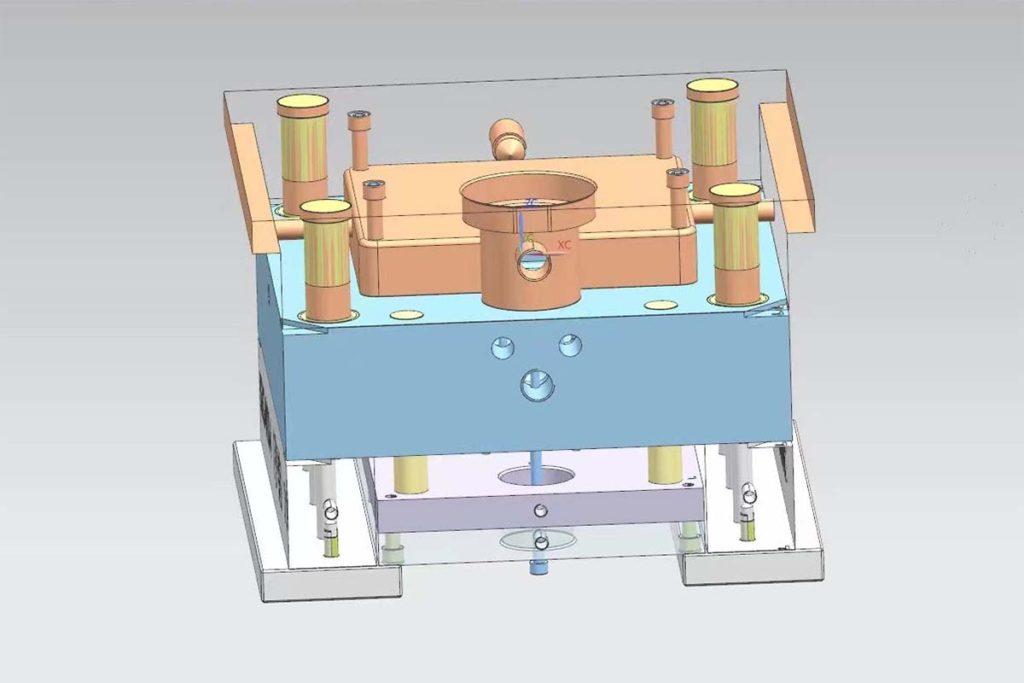
This 12 Major Injection Moulding Processes Explained article talks about what is injection moulding and the 8 kinds of injection moulding processes processing, advantages, disadvantages, and applications of each injection moulding process.
What is injection moulding?
Injection moulding (U.S. spelling: injection molding) is a manufacturing process for producing parts by injecting molten material into a mould, or mold.
What is injection moulding process?
The injection moulding process is a process in which molten raw materials are pressurised, injected, cooled and separated to produce semi-finished parts of a certain shape.
How many steps of injection moulding process? What are they?
There are six steps of injection moulding process.
The injection moulding process steps mainly include mould closing, filling, (gas-assisted, water-assisted) pressure-holding, cooling, mold opening and demolding.
What are the main injection moulding process steps?
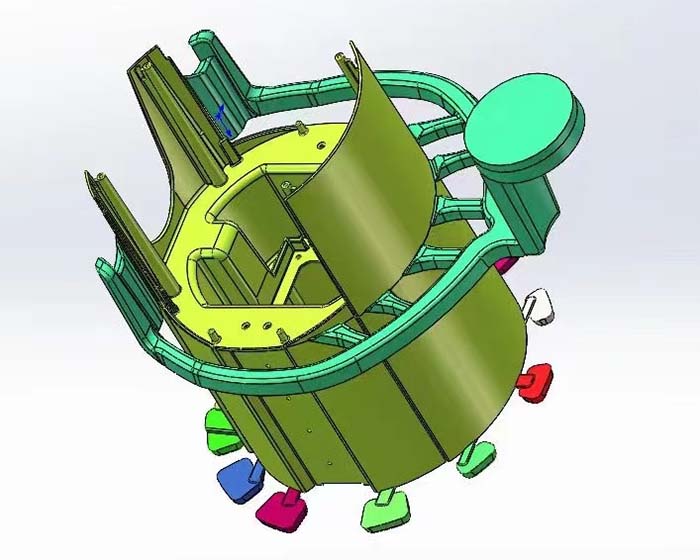
Injection moulding process steps 1 - Filling
Filling is the first step in the whole injection moulding cycle. The time is counted from the time the mould is closed to start injection moulding until the mould cavity is filled to about 95%.
Theoretically, the shorter the filling time, the higher the molding efficiency, but in practice, the moulding time or injection speed is subject to many conditions.
High-speed filling.
The high shear rate at high filling speeds results in a reduction in the viscosity of the plastic due to the shear thinning effect, which reduces the overall flow resistance.
Localised viscous heating effects can also result in a thinner cured layer thickness. During the flow control phase, therefore, the filling behaviour often depends on the volume to be filled.
That is, during the flow control phase, the shear thinning effect of the melt tends to be large due to high speed filling, while the cooling effect of the thin wall is not significant and the utility of the rate prevails.
Low-rate filling.
When filling at low rates of heat transfer control, the shear rate is lower, the local viscosity is higher and the resistance to flow is greater. Due to the slower rate of thermoplastic replenishment, the flow is slower, making the heat transfer effect more pronounced and heat is quickly carried away for the cold mould wall.
And a smaller amount of viscous heating phenomenon, the thickness of the curing layer is thicker, and further increase the flow resistance of the thinner part of the wall.
Due to the fountain flow, in front of the flow wave of plastic polymer chain row to almost parallel to the front of the flow wave. Therefore, when two strands of plastic melt meet, the polymer chains at the contact surface are parallel to each other.
Moreover, the different properties of the two melt streams (different retention times in the mould cavity, different temperatures and pressures) result in a microscopically poorer structural strength in the melt intersection area.
When the part is placed at the right angle in the light and observed with the naked eye, a clear joint line can be found, which is the mechanism for the formation of melt marks.
Not only do melt marks affect the appearance of the part, but they also tend to cause stress concentration due to the loose microstructure, which reduces the strength of the part and causes it to fracture.
Generally speaking, in the high-temperature area, the strength of the fusion splice is better, because the high temperature, polymer chain activity is better, can penetrate each other winding, in addition to the high temperature area of the two melt temperature is closer, the thermal properties of the melt is almost the same, increasing the strength of the fusion splice area;
On the contrary, in the low temperature area, the fusion splice strength is poor.
Injection moulding process steps 2 - Holding injection moulding pressure
The role of the pressure-holding Injection moulding process step is to continuously apply pressure to compact the melt and increase the density of the plastic (densification) to compensate for the shrinkage behavior of the plastic. During the holding pressure process, the back pressure is high as the mould cavity is already filled with plastic.
During the holding pressure compaction process, the injection moulding machine screw can only slowly move forward for a small movement, and the flow of plastic is also slower, which is called holding pressure flow at this time.
As the plastic is cooled and cured by the mould wall, the viscosity of the melt increases very quickly, so there is a lot of resistance in the mould cavity.
In the later stages of holding pressure, the density of the material continues to increase and the moulded part is gradually formed, the holding pressure phase should continue until the gate is cured and sealed, at which point the cavity pressure in the holding pressure phase reaches its highest value.
During the holding phase, the plastic is partially compressible due to the high pressure. In the higher pressure areas, the plastic is denser and more dense.
At lower pressures, the plastic is looser and less dense, resulting in a density distribution that varies with position and time. The flow rate of the plastic is extremely low during the holding process and flow no longer plays a dominant role.
Pressure is the main factor influencing the holding process. During the holding process the plastic has filled the mould cavity and the gradually curing melt is used as the medium for transferring pressure.
The pressure in the cavity is transferred to the surface of the mould wall by means of the plastic, which has a tendency to open the mould and therefore requires an appropriate clamping force to lock the mould. Under normal circumstances, the clamping force will slightly open the mould, which is helpful for the exhaust of the mould.
However, if the clamping force is too high, it may cause burrs, overflow or even open the mould. Therefore, when choosing an injection moulding machine, you should choose an injection moulding machine with a large enough clamping force to prevent the mould from rising and to effectively maintain pressure.
Injection moulding process steps 3 - Cooling
In injection moulding, the design of the cooling system is very important. This is because the moulded plastic product can only be cooled and cured to a certain level of rigidity in order to avoid deformation of the plastic product due to external forces after demoulding.
As cooling time accounts for approximately 70% to 80% of the entire moulding cycle, a well-designed cooling system can significantly reduce moulding time, increase injection moulding productivity and reduce costs.
A poorly designed cooling system will increase the moulding time and cost; uneven cooling will further cause warping and deformation of the plastic product.
According to experiments, the heat entering the mould from the melt is emitted in two parts: 5% is transferred to the atmosphere by radiation and convection, and the remaining 95% is transferred from the melt to the mould.
Due to the cooling water pipe in the mould, the heat is transferred from the plastic in the cavity to the cooling water pipe by heat conduction through the mould frame and then taken away by the cooling liquid through heat convection.
The small amount of heat that is not carried away by the cooling water continues to be conducted in the mould until it is dissipated in the air after contact with the outside world.
The moulding cycle of injection moulding consists of mould closing time, filling time, holding time, cooling time and demoulding time. The cooling time accounts for the largest proportion of this time, approximately 70% to 80%. Therefore, the cooling time will directly affect the length of the plastic molding cycle and the size of the output.
The temperature of the plastic product at the demoulding stage should be cooled to a temperature lower than the heat deflection temperature of the plastic product to prevent the plastic product from relaxation due to residual stress or warping and deformation caused by the external force of demoulding.
Factors affecting the cooling rate of the product are.
Plastic product design aspects:
The main factor is the wall thickness of the plastic product. The greater the thickness of the product, the longer the cooling time.
In general, the cooling time is approximately proportional to the square of the thickness of the plastic product or 1.6 times the maximum runner diameter. This means that doubling the thickness of the plastic product increases the cooling time by a factor of 4.
Mould materials and their cooling methods:
The mould material, including the mould core, cavity material and mould frame material, has a significant impact on the cooling rate. The higher the thermal conductivity of the mould material, the better the heat transfer from the plastic per unit time, and the shorter the cooling time.
Cooling water pipe configuration:
The closer the cooling water pipes are to the mould cavity, the larger the diameter of the pipes and the greater the number, the better the cooling effect and the shorter the cooling time.
Coolant flow rate:
The higher the flow of cooling water (generally to achieve turbulent flow), the better the effect of cooling water to take away heat in the form of thermal convection.
Nature of the coolant:
The viscosity and heat transfer coefficient of the coolant will also affect the heat transfer effect of the mould. The lower the viscosity of the coolant, the higher the heat transfer coefficient and the lower the temperature, the better the cooling effect.
Plastic selection:
The plastic’s is a measure of how quickly the plastic conducts heat from a hot to a cold area. The higher the thermal conductivity of the plastic, the better the heat transfer, or the lower the specific heat of the plastic, the easier the temperature change, so the heat can easily escape, the better the thermal conductivity and the shorter the cooling time required.
Processing parameter setting. The higher the material temperature, the higher the mould temperature and the lower the ejection temperature, the longer the cooling time.
Design rules for cooling systems.
The cooling channels should be designed so that the cooling effect is uniform and rapid.
The purpose of the cooling system is to maintain proper and efficient cooling of the mould. Cooling holes should be of standard size to facilitate machining and assembly.
When designing a cooling system, the mould designer must determine the following design parameters based on the wall thickness and volume of the moulded part: the location and size of the cooling holes, the length of the holes, the type of holes, the configuration and connection of the holes and the flow rate and heat transfer properties of the coolant.
Injection moulding process steps 4 - Demoulding
Demoulding is the last part of the injection moulding cycle. Although the product has been cold-set, demoulding still has an important impact on the quality of the product. Improper demoulding may result in uneven forces on the product during demoulding and deformation of the product during ejection.
There are two main types of demoulding: top bar demoulding and stripper plate demoulding. The design of the mould should be based on the structural characteristics of the product to choose the appropriate release method to ensure product quality.
For moulds with a top bar, the top bar should be set as evenly as possible and positioned at the place with the greatest resistance to release and the greatest strength and stiffness of the moulded part to avoid deformation and damage to the moulded part.
The stripping plate is generally used for the demoulding of deep cavity thin walled containers and transparent products that do not allow traces of the push rod. This mechanism is characterised by a large and even demoulding force, smooth movement and no obvious traces left behind.
What are the injection moulding processes?
Here are the introduction to 8 different injection molding processes.
1. Injection moulding process
The principle of injection moulding is to add granular or powdered raw materials to the hopper of the injection machine. The raw materials are heated and melted into a flowing state, pushed by the screw or piston of the injection machine, through the nozzle and the pouring system of the mould into the mould cavity, where they are hardened and shaped.
What is injection moulding processing?
Elements affecting the quality of injection moulding: injection pressure, injection time, injection temperature.
Injection moulding process characteristics.
Advantages of the injection moulding process:
(1) Short cycle time, high production efficiency, easy automation
(2) The ability to mould plastic parts with complex shapes, precise dimensions and metal or non-metal inserts
(3) Stable product quality
(4) Wide range of applications
Disadvantages of the injection moulding process.
(1) High cost of injection moulding equipment
(2) Complex injection mould structure
(3) High production cost, long production cycle, not suitable for single piece and small batch production
Injection moulding process applications:
In industrial products, injection moulded products include: kitchenware (bins, bowls, buckets, jugs, tableware and various containers), housings for electrical equipment (hair dryers, hoovers, food mixers, etc.), toys and games, various products for the automotive industry, parts for many other products, etc.
2. Insert moulding process
What is Insert molding?
Insert molding refers to the injection of resin into the mold after the injection of a pre-prepared insert of a different material, the molten material and the insert are joined and cured to make an integrated product.
What is insert moulding processing?
In the insert moulding process, the injection moulding machine is usually only one part of the overall system. The insert usually needs to be oriented first, and this can be done with a vibrating table. The insert is then inserted into the mould by a robotic end-of-arm tool (EOAT), usually with the aid of a pre-positioning device.
After reaching the finished part stage, ejector positioning is the most important step and the repeatability of the injection moulding machine’s opening action is crucial here. Once the insert has been closed into the mould, it is held in place by vacuum or by mechanical means (e.g. by means of a ram). At the same time as the insert is inserted, the previous finished part is ejected.
Technical characteristics of the insert moulding process.
(1) Pre-formed combination of several inserts, making the post-engineering of the product unit combination more rational.
(2) The combination of the ease of moulding and bending of resin with the rigidity, strength and heat resistance of metal can be used to make complex and sophisticated metal-plastic products.
(3) In particular, the combination of the insulating properties of resin and the electrical conductivity of metal enables the production of moulded products that meet the basic functions of electrical products.
(4) For rigid molded products and bending elastic molded products on rubber gaskets, after the integrated products are made by injection molding on the substrate, the complex operation of arranging the seals can be eliminated, making it easier to automate the combination of the post-process.
3. Two-colour injection moulding process
The two-colour injection moulding process is a method of moulding in which two different shades of plastic are injected into the same mould. It can make the plastic appear in two different colours, and can make the plastic parts present regular patterns or irregular cloud-like patterns, in order to improve the usability and beauty of the plastic parts.
What is two-colour injection moulding processing?
Technical characteristics of two-colour injection moulding process.
(1) The core material can be used with low viscosity to reduce the injection pressure.
(2) For environmental reasons, recycled secondary materials can be used for the core material.
(3) Depending on the characteristics of the application, e.g. a soft material for the skin layer of thick parts, a hard material for the core material or a foamed plastic for the core material can be used to reduce the weight.
(4) Lower quality core materials can be used to reduce costs.
(5) Expensive skins or cores with special surface properties such as EMI protection, high electrical conductivity, etc. can be used to increase product performance.
(6) Appropriate skin and core compounds can be used to reduce residual stress, increase mechanical strength or surface properties of the moulded product.
4. Microfoam injection moulding process
Microfoam injection moulding is an innovative precision injection moulding technology, which relies on the expansion of the pores to fill the product, and completes the moulding of the part under a low and average pressure.
The basic principle of microfoam injection moulding.
The microcellular foam moulding process can be divided into three stages: firstly, a supercritical fluid (carbon dioxide or nitrogen) is dissolved into the hot melt to form a single-phase solution.
This is followed by the injection of a switch nozzle into the mould cavity where the temperature and pressure are low. The lowering of temperature and pressure triggers molecular instability, resulting in the formation of a large number of bubble nuclei in the product, which gradually grow into tiny holes.
What is Microfoam injection moulding processing?
Microfoam injection moulding process features.
(1) Precision injection moulding.
(2) Breakthrough the many limitations of traditional injection moulding, can significantly reduce the weight of the parts, shorten the molding cycle.
(3) Greatly improve the warpage and dimensional stability of the part.
Microfoam injection moulding process applications.
Automobile instrument panels, door panels, air conditioning ducts, etc.
5. Nanometer (NMT) injection molding process
Nano Moulding Technology (NMT) is a combination of metal and plastic with nano-technology, the first metal surface after nano-treatment, plastic injection molding directly on the metal surface, so that metal and plastic can be formed as one.
What is Nano-injection moulding processing?
Nanomoulding technology is divided into two types of processes depending on the location of the plastic.
(1) One-piece moulding where the plastic is a non-appearance surface
(2) One-piece moulding where the plastic is the external surface
Features of the nano-injection moulding process.
(1) The product has a metallic appearance and texture.
(2) Simplification of the design of the product mechanism, making the product lighter, thinner, shorter and smaller, and more cost effective than the CNC machining method.
(3) Reduced production costs and high bonding strength, as well as a significant reduction in the use of related consumables.
Suitable metal and resin materials of nano-injection moulding process
(1) Aluminium, magnesium, copper, stainless steel, titanium, iron, galvanised sheet metal, brass.
(2) Aluminium alloys are highly adaptable, including the 1000 to 7000 series.
(3) Resins include PPS, PBT, PA6, PA66, PPA.
(4) PPS has a particularly strong bonding strength (3000 N/cm).
Nano injection moulding process applications.
Mobile phone casing, laptop casing, etc.
6. Extrusion moulding (profile) process
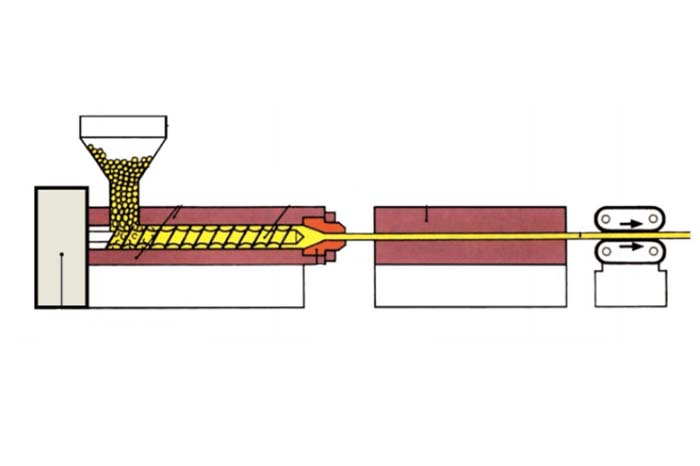
Extrusion moulding, also known as extrusion molding, is mainly suitable for the moulding of thermoplastics, but also for the moulding of thermosets and reinforced plastics with good fluidity.
The extrusion process involves the use of a rotating screw to extrude the heated and molten thermoplastic material from a head with the required cross-sectional shape, then shaped by a shaper and then cooled and cured by a cooler to make the product of the required cross-section.
What is the extrusion processing?
Extrusion moulding process features.
(1) Low cost of equipment.
(2) Simple operation, easy control of the process, easy to achieve continuous automatic production.
(3) High production efficiency; uniform and dense product quality.
(4) Various cross-sectional shapes of products or semi-finished products can be formed by changing the head orifice die.
Extrusion molding process applications.
In the field of product design, extrusion has a strong applicability. Extruded products include tubes, films, rods, monofilaments, flat strips, nets, hollow containers, windows, door frames, plates, cable cladding, monofilaments and other special profiles.
7. Calendering (sheet, film)moulding process
The calendering moulding process is a series of heated press rolls through which plastic materials are extruded and spread to form a film or sheet.
What is calendering moulding processing?
Calendering moulding process characteristics.
Advantages of the calendering moulding process.
Good product quality, high production capacity, automatic and continuous production.
Disadvantages of the calendering moulding process.
The disadvantages of the calendering process are: large equipment, high precision requirements, many auxiliary equipment, width of the product is limited by the length of the calender rollers.
Applications of the calendering moulding process.
Mostly used in the production of PVC soft film, sheet, sheet, artificial leather, wallpaper, floor leather, etc.
8. Blow moulding process
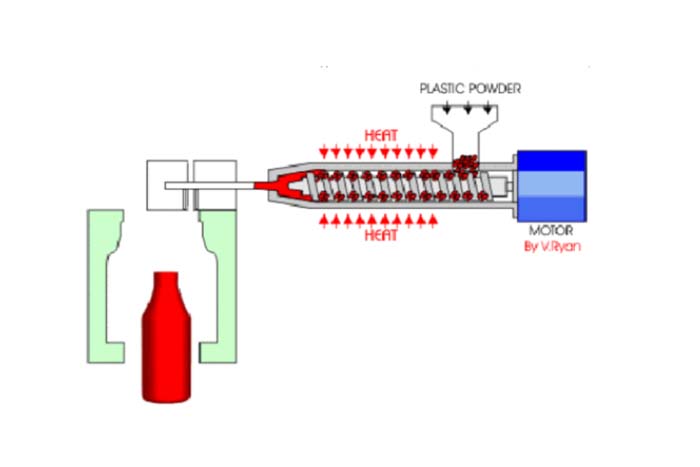
Blow moulding process is the extrusion of molten thermoplastic raw materials from the extruder, clip into the mold, and then blow air into the raw materials, molten raw materials in the air pressure under the action of expansion, to the mold cavity wall fit, and finally cooled and cured into the desired product shape method.
Blow moulding process is divided into film blow moulding and hollow blow moulding two kinds.
8.1. Film blow moulding process
Film blow moulding process is the molten plastic from the extruder head mouth die ring gap in a cylindrical thin tube extrusion, while the head from the central hole into the thin tube cavity blowing compressed air, the thin tube will be expanded into a larger diameter tubular film (commonly known as bubble tube), after cooling and rolled.
8.2. Hollow blow moulding process
Hollow blow moulding process is with the help of gas pressure, will be closed in the mould cavity in the rubber-like state of the blank blowing into hollow products of the secondary molding technology, is the production of hollow plastic products method. Hollow blow moulding according to the different manufacturing methods of the blank, there are extrusion blow moulding, injection blow moulding, stretch blow moulding.
(1) extrusion blow moulding process is to use the extruder to extrude tubular blanks, while it is hot to clamp it in the mould cavity and seal the bottom, and then to the cavity of the blanks into the compressed air blow molding.
(2) The injection blow moulding process uses blanks obtained by injection moulding. The billet is left in the core of the mould, and after the mould is closed with the blow mould, compressed air is passed through the core mould to expand the billet, cool it down and take off the mould to obtain the product.
Advantages:
Uniform wall thickness, small weight tolerance, less post-processing, small waste edges; suitable for the production of large quantities of small fine products.
(3) Stretch blow moulding: the billet is heated to stretching temperature and placed in the blow mould, then stretched longitudinally with a stretching bar and blown horizontally with compressed air blown into it to obtain the product.
Hollow blow moulding process applications.
Film blow moulding is mainly used to make thin plastic moulds.
Hollow blow moulding is mainly used to make hollow plastic products (bottles, buckets, spray cans, fuel tanks, cans, toys, etc.).
9. Compression moulding process
Compression moulding is mainly used for the moulding of thermosetting plastics. According to the characteristics of moulding materials and processing equipment and techniques, compression moulding can be divided into moulding and lamination moulding.
9.1. Moulding processing
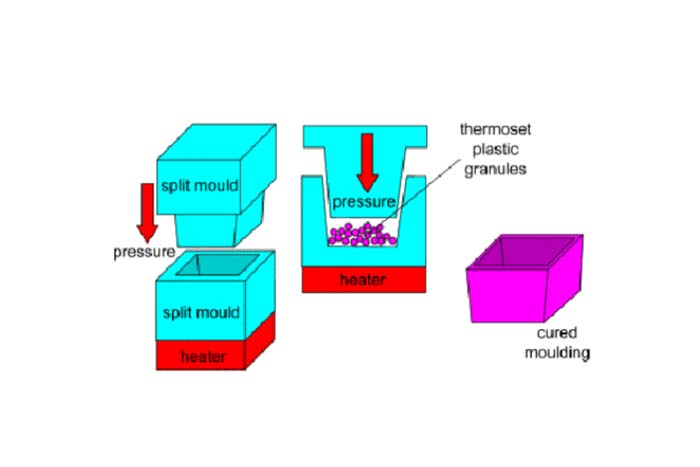
Moulding, also known as compression moulding, is the main method of forming thermosetting plastics and reinforced plastics. The process is to pressurise the raw materials in a mould that has been heated to a specified temperature, so that the raw materials melt and flow and fill the mould cavity evenly, under heated and pressurised conditions after a certain period of time, so that the raw materials form products.
Features of the moulding processing.
Moulded products are dense, dimensionally accurate, smooth and clean in appearance, free of sprues and stable.
Applications of the moulding process.
In industrial products, moulded products include electrical equipment (plugs and sockets), pot handles, handles for tableware, bottle caps, toilets, unbreakable dinner plates (Minecraft), carved plastic doors, etc.
9.2. Laminated moulding process
Laminated moulding is a method of combining two or more layers of the same or different materials into a whole under heated and pressurised conditions, using sheet or fibrous materials as fillers.
What is the laminating processing?
The laminating process consists of three stages: impregnation, pressing and post-processing, and is used to produce reinforced plastic sheets, tubes, rods and model products.
Features of the laminating process.
Dense texture, smooth and clean surface.
10. Plastic compression injection moulding process
Plastic compression moulding is a method of forming thermosetting plastics based on compression moulding, also known as transfer moulding.
The plastic compression moulding process is similar to the injection moulding process, in which the plastic is plasticised in the filling cavity of the mould and then enters the cavity through the pouring system, while the injection moulding is plasticised in the barrel of the injection moulding machine.
What is compression moulding processing?
The difference between plastic compression moulding and compression moulding.
Plastic compression moulding is the process of adding material before closing the mould, whereas compression moulding generally requires the mould to be closed before adding material.
Features of the plastic compression moulding process.
Advantages of plastic compression moulding: (compared with compression moulding)
(1) The plastic is plasticised before it enters the cavity, enabling the production of complex shapes, thin-walled or highly variable wall thicknesses and fine inserts.
(2) Shortening the moulding cycle, increasing productivity and improving the density and strength of the moulded part.
(3) As the mould is completely closed before the plastic is moulded, the flange on the parting surface is very thin, so the accuracy of the plastic part can be easily guaranteed and the surface roughness is low.
Disadvantages of the plastic compress injection moulding process.
(1) There is always a portion of residual material left in the filling chamber, resulting in a high consumption of raw materials.
(2) The workload is increased by the repair of the gate marks.
(3) The moulding pressure is higher than that of compression moulding; the shrinkage rate is higher than that of compression moulding.
(4) The structure of the mould is also more complex than that of a compression mould.
(5) The process conditions are more stringent than compression moulding and the operation is more difficult.
11. Rrotational moulding process
Rotational moulding is the first plastic raw materials into the mould, and then the mould along the two vertical axis of continuous rotation and make it heated, so that the plastic materials in the mould under the action of gravity and heat, gradually and evenly coated, molten adhesion on the entire surface of the cavity, forming the required shape, and then by cooling and shaping, demoulding, and finally obtain the product.
What is rotational moulding processing?
Advantages of the rotational moulding process.
(1) Provides more design space and reduces assembly costs.
(2) Simple changes and low cost.
(3) Savings in raw materials.
Applications of the rotomoulding process.
Water balloons, floating balls, small swimming pools, bicycle saddles, surfboards, machine housings, protective covers, lampshades, agricultural sprayers, furniture, canoes, camping vehicle roofs, etc.
12. Drip moulding process
Drip moulding is the use of thermoplastic polymer materials with the characteristics of variable state, that is, under certain conditions with viscous flow, but at room temperature and can return to the characteristics of solid, and the use of appropriate methods and special tools inkjet, in its viscous flow state according to the requirements of the shape of the design, and then at room temperature curing moulding.
What is the drip moulding processing?
The process consists of three main stages: weighing – drip moulding – cooling and curing.
Advantages of the drip moulding process.
(1) Good transparency and gloss of the product.
(2) Anti-friction, waterproof, anti-pollution and other physical properties.
(3) Unique three-dimensional effect.
Application of drip moulding process.
Plastic gloves, balloons, condoms, etc.
Besides the 12 Major Injection Molding Processes Explained article, you may also be interested in the below.
Stamping Die Design Guidelines, 75 Taboos And Rules
Mechanical Design Steps and 525 Taboos
6 Common Plastic Injection Molding Process Techniques
What is Multi-material Injection Molding?
How to Increase the Brightness of ABS Plastic Products?
Hot Runner Injection Molding Defects and Troubleshooting
